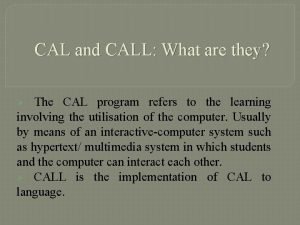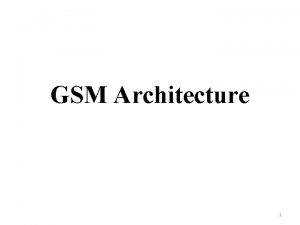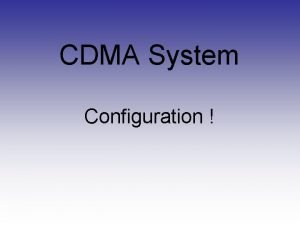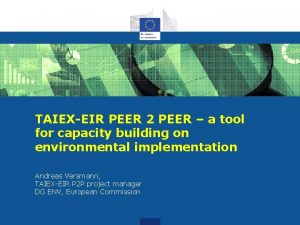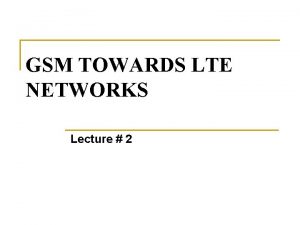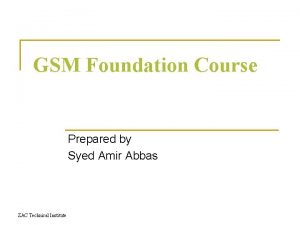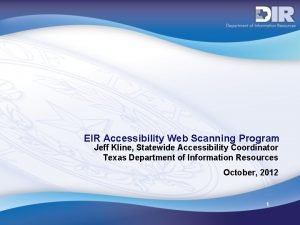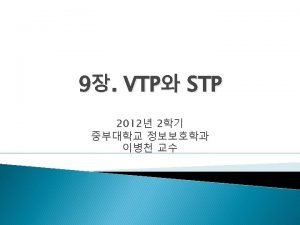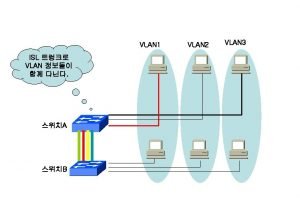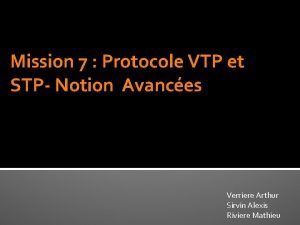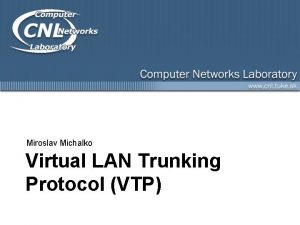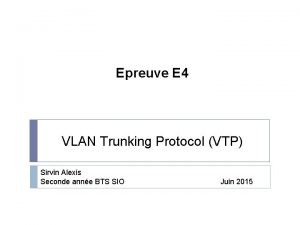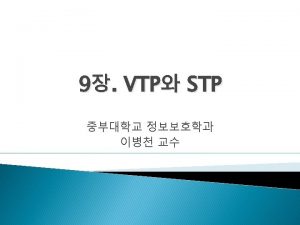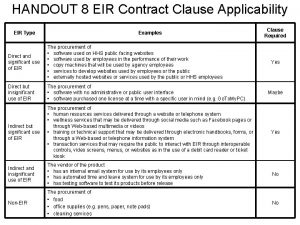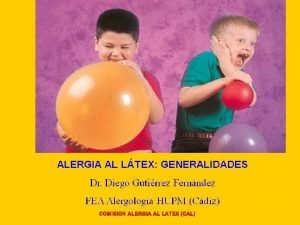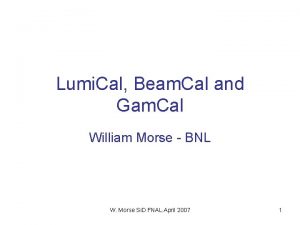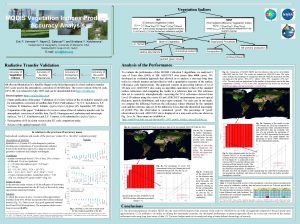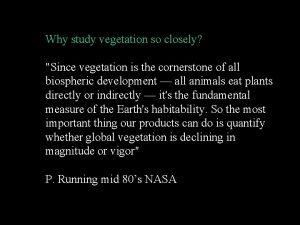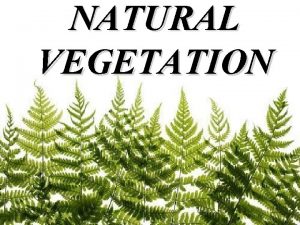California Vegetation Treatment Program Cal VTP Program EIR














- Slides: 14

California Vegetation Treatment Program (Cal. VTP) Program EIR California State Lands Commission Meeting December 6, 2019 Matt Dias, Executive Officer Board of Forestry and Fire Protection Heather Blair, Project Manager Ascent Environmental Cal. VTP@bof. ca. gov

Presentation Objectives Provide information on the proposed California Vegetation Treatment Program (Cal. VTP) Provide information on the Program Environmental Impact Report (PEIR) and CEQA review process for the Cal. VTP • Intended uses of the PEIR • Project-Specific Analysis (PSA) approach 2

Background State Board of Forestry and Fire Protection is proposing the Cal. VTP CAL FIRE and other public agencies will implement the Cal. VTP to reduce wildfire risks and avoid or diminish the harmful effects of wildfire on the people, property, and natural resources in the State of California The Board released the Final Program EIR on November 27, 2019 • Final Program EIR will be considered for certification in December 2019 • SB 632 mandates certification of the Program EIR by February 1, 2020 3

Cal. VTP: Program vs PEIR The Cal. VTP would treat approximately 250, 000 acres annually of nonfederal land to reduce wildfire risk and establish more natural fire regimes The Cal. VTP PEIR contains an analysis of the physical environmental impacts of implementing the vegetation treatments proposed in the Cal. VTP The Cal. VTP PEIR is one tool intended to help implement Governor Brown’s Executive Order B-52 -18 mandating an increase in the pace and scale of fire fuel treatment programs to reduce wildfire risk Defensible space, building codes, land use decisions, timber harvesting, and other fire prevention programs work together with the Cal. VTP to create a more fire safe California, but are not addressed in the PEIR 4

Cal. VTP Program Area Treatments would occur within the “Treatable Landscape” Defined as the portion of the SRA considered suitable for vegetation treatments 20. 3 million acres total 65, 620 acres of CSLC land Treatable landscape viewer available online • https: //bofdata. fire. ca. gov/projects-andprograms/calvtp/ 5

Cal. VTP Program Description Proposed Treatment Types : Wildland-Urban Interface (WUI) fuel reduction - focused in WUIdesignated areas and generally consist of treatments to reduce fuel loads and slow or prevent the spread of fire between wildlands and structures, and vice versa; Fuel breaks - are strategically placed vegetation treatment areas that actively support fire-control activities; and Ecological restoration projects - generally occur outside the WUI in areas that have departed from the natural fire regime as a result of fire exclusion, and would focus on restoring ecosystem processes, conditions, and resiliency. 6

Cal. VTP Program Description Proposed Treatment Activities : Prescribed burning Manual vegetation treatment Mechanical vegetation treatment Prescribed herbivory (targeted grazing) Targeted ground application of herbicides 7

requires a CDP by the Coastal Commission or a local government with a certified LCP Cal. VTP Program Description Standard Project Requirements (SPRs): Part of the proposed program to avoid and minimize environmental impacts and comply with applicable laws and regulations Will be incorporated into later vegetation treatments under the Cal. VTP as a standard part of treatment design and implementation The product of coordinated interagency efforts • Coastal Commission, Department of Fish and Wildlife, Air Resources Board, State Water Quality Control Board 8

CAL FIRE, or any another public agency funded by CAL FIRE grants from CAL FIRE or other state agencies, or a public agency with land ownership or management responsibilities in the treatable landscape that is seeking to i Program EIR CEQA allows for use of a Program EIR for a series of actions that can be characterized as one large project and are related to a continuing program A PEIR facilitates CEQA review of site-specific, later vegetation treatment projects consistent with the PEIR Designed for use by many agencies • “Project Proponent”: CAL FIRE or other public agency providing funding for vegetation treatment or with land ownership and/or management responsibilities in the treatable landscape A project proponent must incorporate all standard project requirements relevant to the proposed activity and all feasible mitigation measures from the PEIR into the later activity, as needed, to address potentially significant effects 9

Topics Addressed in the PEIR (Full-scope EIR) Aesthetics and Visual Resources Agriculture and Forestry Resources Air Quality Archeological, Historic, and Tribal Cultural Resources Biological Resources Geology, Soils, and Mineral Resources Greenhouse Gas Emissions Energy Resources Hazardous Materials, Public Health and Safety Hydrology and Water Quality Land Use and Planning, Population and Housing Noise Recreation Transportation Public Services, Utilities and Service Systems Wildfire Cumulative Effects 10

Intended Use of the Cal. VTP Program EIR Evaluate the later vegetation treatment project to determine whether the project is consistent with the activities in the Cal. VTP and would have effects that were analyzed in the PEIR • Evaluation documented in Project-specific Analysis If the later activities are found to be “within the scope” of the Cal. VTP PEIR, no additional CEQA document need be prepared or circulated to the public • An NOD will be filed if the project is approved Where later activities do not qualify for a “within the scope” finding, the PEIR can be used to focus only on the impacts that are new or substantially more severe in a site-specific ND, MND, or EIR 11

Project-specific Analysis Cal. VTP will facilitate an increase in pace and scale, while maintaining environmental protections • For use by many project proponent agencies • Maximize “within the scope” findings • Focus content of EIRs, MNDs, if necessary Public availability of information • Planned, Approved, and Completed stages of projects 12

Schedule and Next Steps Schedule Final PEIR Released November 2019 Board considers Cal. VTP approval and PEIR certification December 2019 Next Steps Implementation, including PSA training Continued interagency coordination 13

Thank you! Questions? 14
